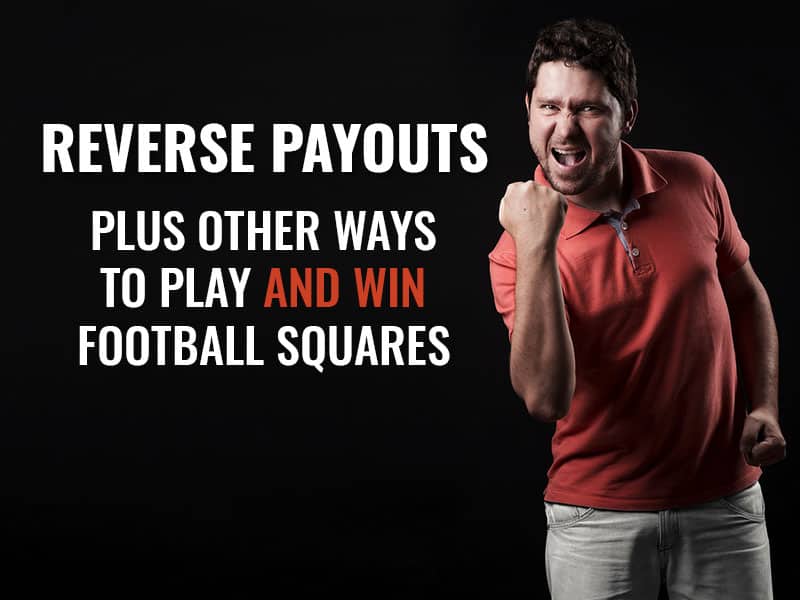Football Squares, also called Super Bowl Squares, are an excellent way to get the fans more involved in the game while adding the possibility of winning a few bucks. You’ve seen the 10 x 10 squares circulating offices and friend groups for years and could be looking for ways to spice it up. Have you heard about reverse payouts? What are a few other ways that you can play super bowl squares?
Technology has updated the game to make it easier and faster to pick the squares and pay the winners. There are also several variations that you can use that will provide more winners or a different way of picking the winners. Read on and learn about reverse payouts in football squares and other exciting ways to play.
Reverse Payouts in Football Squares
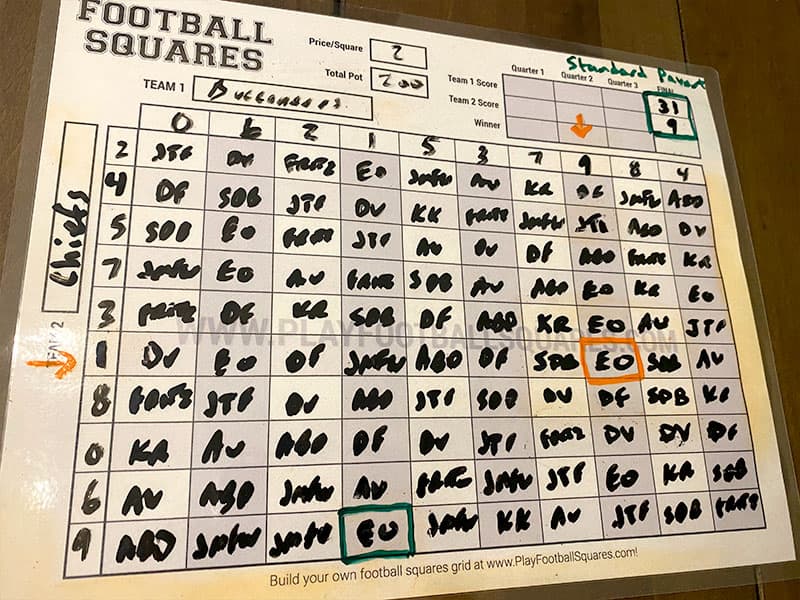
Reverse payouts give the game a bit more interest than regular squares. The big rub with reverse payouts is that the person with each team score’s reverse outcome also wins. For example, for a standard football squares game, if the final score was 9 to 31 then Team1 has the 9, and Team2 has the 1. So in a reverse payout, the person who has Team2’s 9 and Team1’s 1 will get a smaller payout. Don’t worry, I’ll provide a more detailed example later to illustrate reverse payouts and some of the other alternatives.
The smaller payouts mean that more people win each quarter. The more winning possible, the more interested the contestants will become in the game. So while the payouts could be smaller, seeing other people win opens something inside that makes them want to win. Don’t underestimate the thrill of victory to overtake the love for money.
The best things about a reverse payout Super Bowl squares are:
- More Winning – When people win, they want to do it again. The thrill of gambling, even on a small scale like squares, can be a big reason that people watch sports. They feel that winning in squares is comparable to how the athletes feel.
- More Players – More people may get involved with a reverse payout. The feel of winning is infectious, and people will see that if their friends can win, so can they. With more players, the feelings are more widespread, and bragging rights can become real.
Reverse payout squares are an excellent way to mix up the standard game. The extra payouts mean that people are going to like the game as they think their chances of winning are much higher.
Combination Payouts in Football Squares
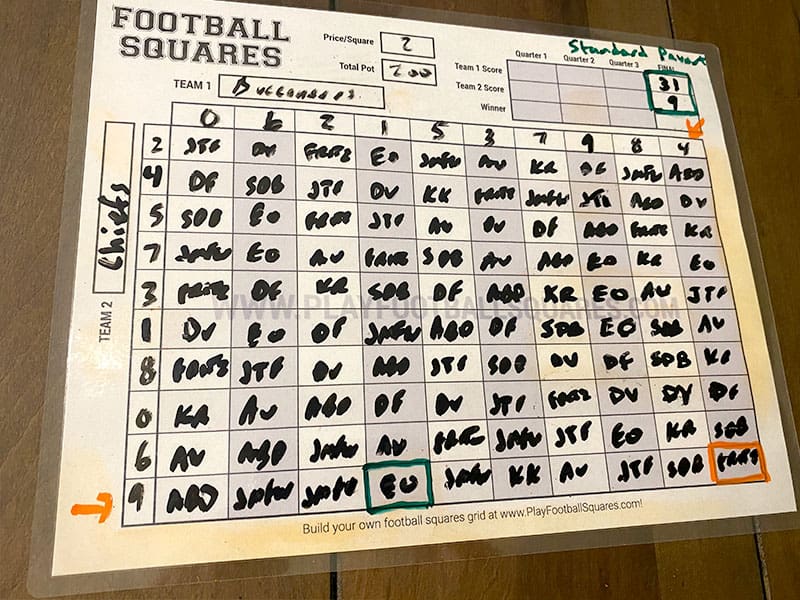
Also called “Both Digit Winners”, combination payouts work by adding both digits of each score to determine the winner. This adds a new wrinkle to the game and is another excellent way to keep people entertained.
With double-digit combo winners, you take the game’s score (Team1 is 9 – Team2 is 31), and add the digits in each team together (Team1 added together is still 9 since it’s just 1 digit and Team2 added together is 4) as another payout (winning player is the square at Team1’s 9 and Team2’s 4). This is usually played as an additional payout to the standard payout.
Neighbor Payouts in Football Squares
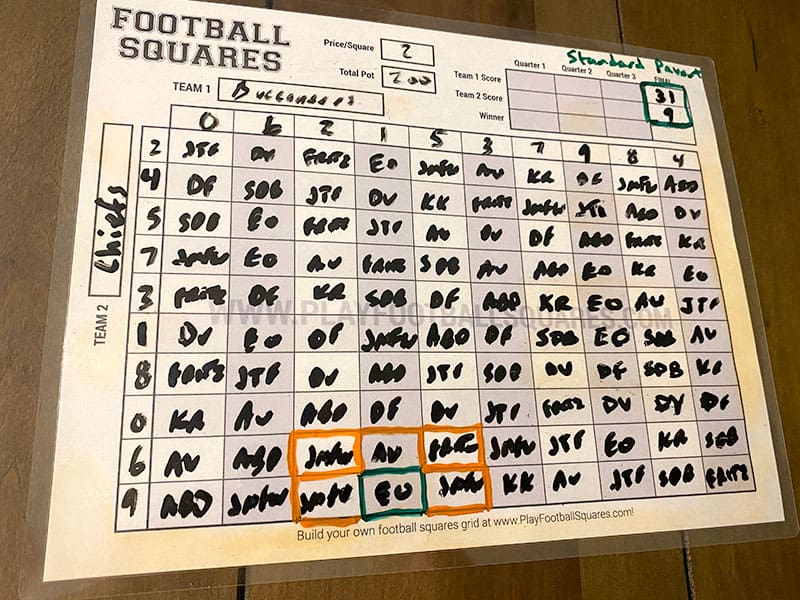
“Neighbors Win” is a payout where everyone has high chances and is a great way to combat the lonely loser crowd. If your square is adjacent to one for the main payout, you will also get a piece of the prize. These games are set up so that people get over the notion that nobody ever wins in Super Bowl square pools.
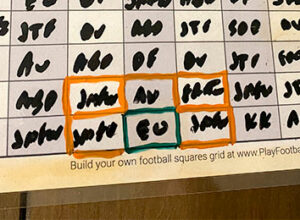
This payout requires a bit of math to calculate though since the payout is split between all neighbors, and can vary based on where the main payout square is. If the square is in the middle, there are 8 neighbors counting diagonal neighbors or 4 neighbors counting just horizontal or vertical neighbors. However, if the primary winning square is in the top right corner (top row, last column) then there would only be 3 neighbors (counting the diagonal square too).
To calculate the neighbors, you’d have to take the total neighbors payout (for this example let’s say the total payout is $100 and 50% is paid to neighbors) and then split it between all the neighboring squares. So if there were 8 neighbors (winning square was in the middle somewhere), then each neighboring square would get a payout of $6.25 ($100 X 50% divided by 8. 100 / 2 / 8 = 6.25). Make sure to have your phone’s calculator app handy!
While reverse, combination, and neighbor payouts are typically used for just the final score, you can also use them with quarterly or half-time payouts.
Example Football Squares Game With Reverse, Combo, and Neighbor Payouts
Now that I’ve introduced some new payouts for Football Squares, let’s jump into an example. We’ll use Super Bowl LV as our example where the Buccaneers won the Chiefs 31 to 9.
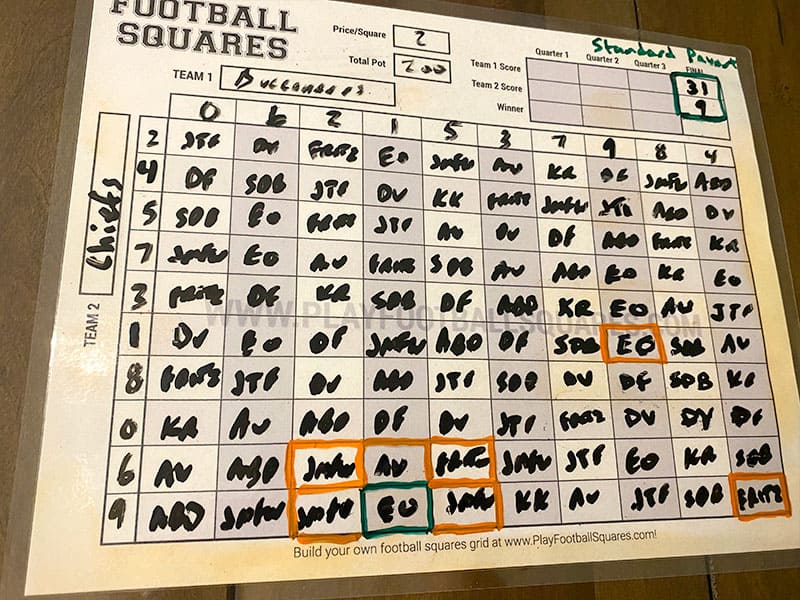
For this game, we’ll go with a square price of $2 and a payout percentage of 40% to the final score and 20% to each of the other payouts (I like to give the final score payout the highest payout).
| Payout | Percent of Winnings | Dollar Winnings | Winner(s) |
|---|---|---|---|
| Final Score Payout | 40% | $80 | EO |
| Reverse Payout | 20% | $40 | EO |
| Combination Payout | 20% | $40 | Fritz |
| Neighbors Payout | 20% | $40, divided by neighbors | JMFW(3), AU, Fritz |
The total prize money that can be won is $200 so that’s what will be split between all the winners. Refer to the above table, and we’ll tally up how much each winner was picked and how much they each get.
For the final score, the winner was the Buccaneer’s 31 and the Chiefs 9 so $80 went to the square for EO. That’s 40% of the total $200.
For the reverse payout, the winner was the square at the Buc’s 9 and the Chief’s 1, so EO also wins this payout of $40 (we had a 20% reverse payout).
For the combination payout, the winner was the square at the Buc’s 4 (adding the 3 and 1 of their score) and the Chief’s 9 (adding 0 and 9). With a 20% payout, Fritz wins $40.
Then with the neighbor payouts, since the winning square was at the bottom of the grid, there’s only 5 neighbors. This makes the math a little easier though, so we divide the $40 payout 5 ways, so $8 each. Since JMFW had 3 neighbor squares, he wins $24. AU and Fritz both with $8 each with their neighbor squares.
Adding it all up, this is what I would pay each of the winners:
- EO gets $120 for the final score payout and reverse payout.
- Fritz gets $48 for combo payout and one of the neighbor squares.
- JMFW gets $24 for having 3 neighbor squares.
- AU gets $8 for having 1 neighbor square.
Hopefully, this example helps you with your scoring. It can get crazy trying to calculate, especially when everyone’s making noise and you may have had a few drinks.
Halves and Quarter Payouts are Fantastic Options in Football Squares
So far, I’ve gone over some different payout options that are probably new to you but now it’s time to cover the more common options for football squares, and then I’ll add a twist.
A half-time payout is when you add an additional payout after the first half. It can be the same amount as the final payout or you may want to give it less weight, perhaps 40% of the pot instead of 60%.
With quarter payouts (much more common), you’ll have payouts at the end of each quarter and many party organizers will put more weight on the final score. For quarter payouts, I typically go with a 20%/20%/20%/40% split.
Now for the twist: Instead of just adding half-time or quarterly payouts, you can also have different scoring numbers for each half or quarter. Focusing on the quarter payouts, instead of assigning 1 set of random numbers 0 through 9 across the top and side, you would assign 4 sets of random numbers, one for each quarter. While this can add a lot of fun, you’ll probably want a poster-sized football squares to fit all those extra numbers on. Or, there are football grids that have the quarterly scoring numbers built in, such as this football square grid with quarter lines.
And of course, with half and quarter payouts, you can also add reverse, combo, or neighbor payouts to switch things up a bit.
A Five by Five Board is Great for Small Groups
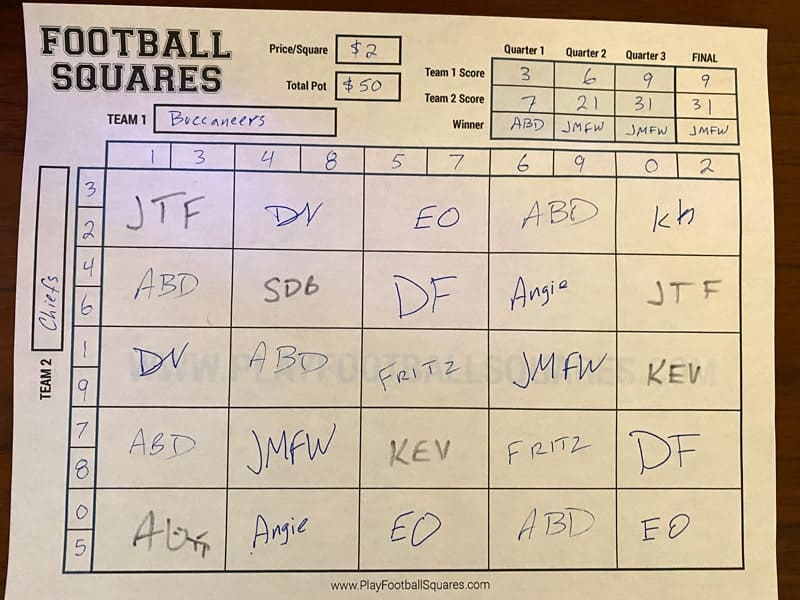
Another great way to bring some new flavor to Super Bowl squares is to make a smaller board. The smaller board gives you lots of advantages, especially for smaller groups. Working with smaller groups is becoming more frequent as players fill rooms online instead of passing printed sheets to a group.
Another wrinkle for 5×5 is to have the squares awarded to teams. People can join up and buy squares as a team, depending on the buy-in price, giving them a bit of community during the game.
5×5 is seriously fun. It makes an excellent platform for people to mingle while keeping their eyes on the game. Having small betting pools, a dollar and under, won’t get people as fired up as high stakes games. Big winnings mean big emotions.
For more info on how to play on a 5×5, check out my article on How a 25-Square Football Board Works, or download my free 5×5 Printable Football Squares!
Conclusion
Reverse payouts, combination payouts, and neighbor payouts let more people get a piece of the pot, and more winners mean more players. The games are intended to enhance the Super Bowl and make a bit of money on the side. It also creates an excellent way for party guests to mingle and know each other while watching the game.
There are several different types of 10×10 square games. They work best for large groups, but some variations can accommodate any amount of people you could invite. Make sure that the winners get their money, and you can count on expanding to games like basketball, hockey, and soccer. Squares is one of those games that gives a thrill no matter how much skin you have in it.
Bonus: What I’m Using This Year
I typically run a few games of football squares and my go-to is the quarter payouts split 20%,20%,20% and 40%. This year, I’ll also run use quarter payouts but with reverse and combo payouts too in one of my games and then neighbor payouts with just the final score for my office pool.


